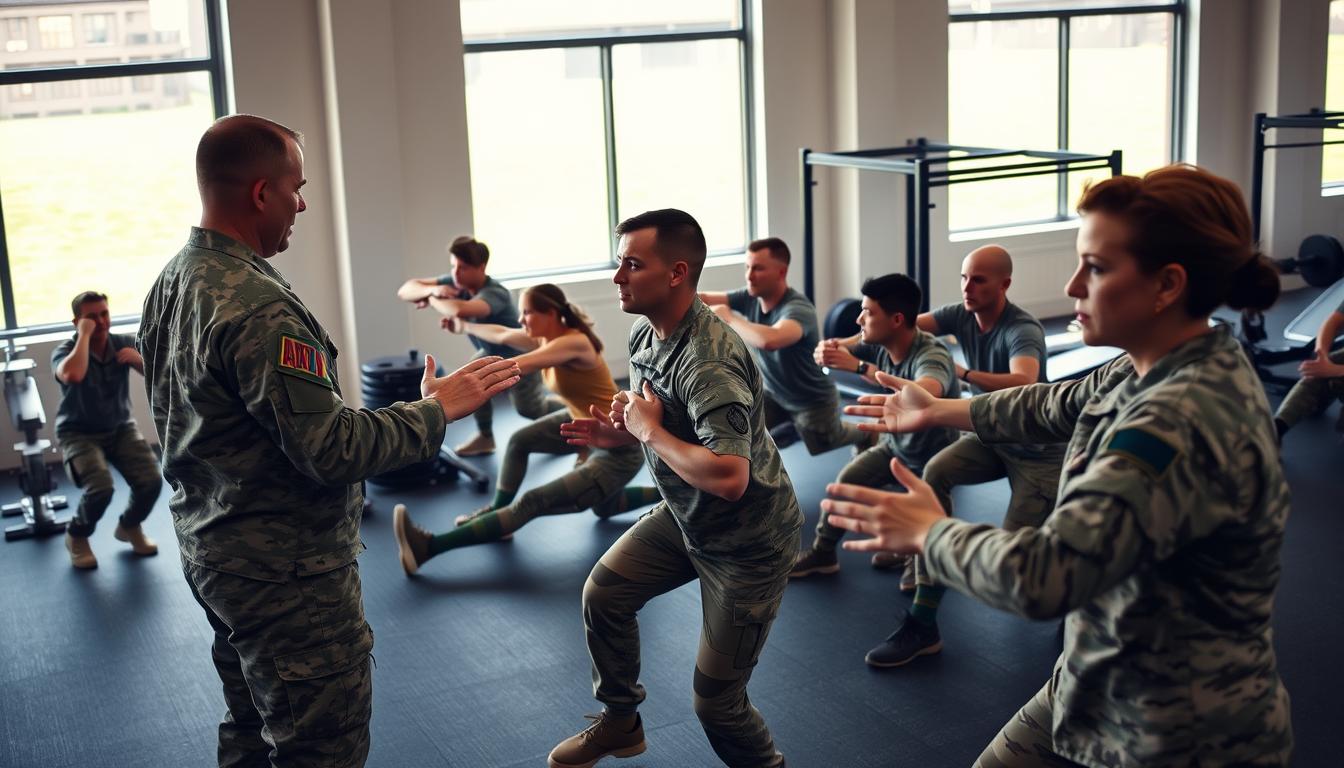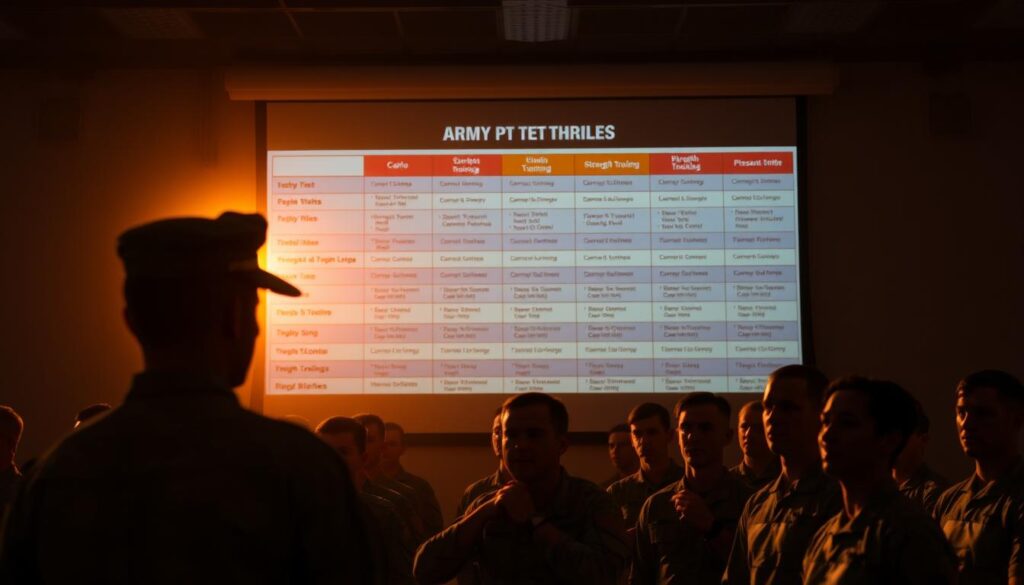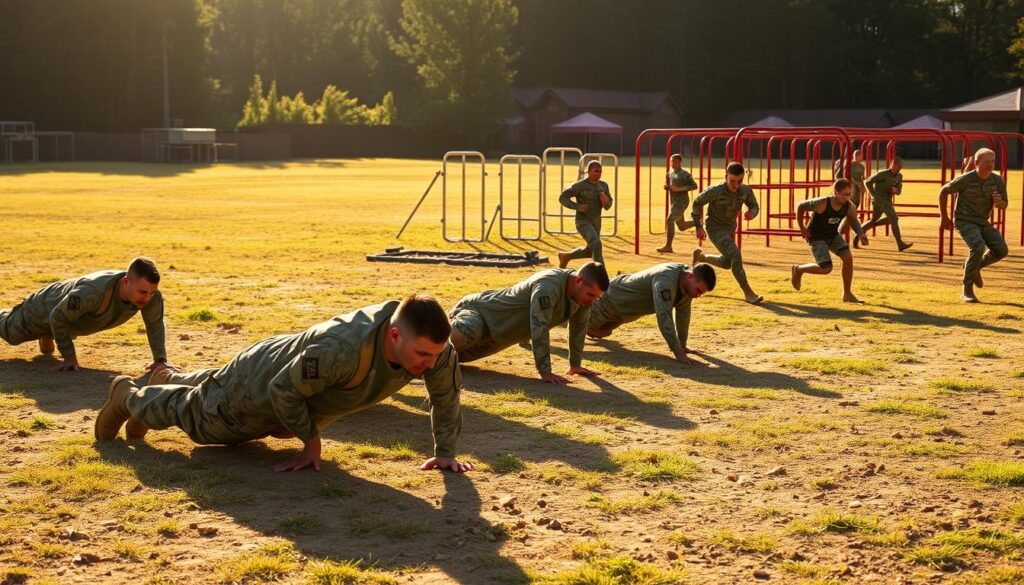Are you ready to excel in the Army Physical Fitness Test and take your fitness to the next level?
The Army’s fitness culture emphasizes the importance of physical readiness. The AFT is a critical assessment of a soldier’s fitness level.
To achieve a high score, it’s essential to understand the test components and develop an effective training strategy.
Key Takeaways
- Understand the test components and scoring system
- Develop a comprehensive training plan
- Focus on exercises that improve overall fitness
- Practice under test-like conditions
- Learn strategies to maximize your score
Understand the Standards of the Army PT Test
To do well in the Army PT test, soldiers need to know its parts and how it’s scored. The Army Physical Fitness Test checks a soldier’s strength, endurance, and agility. It’s a detailed test of physical fitness.
Overview of the PT Test Components
The Army PT test has five parts:
- 3 Repetition Maximum Deadlift
- Hand-Release Push-Up
- Sprint-Drag-Carry
- Plank
- Two-Mile Run
Each part tests a different part of physical fitness. For example, the 3 Repetition Maximum Deadlift checks muscle strength. The Two-Mile Run looks at how well your heart and lungs work.
Scoring Criteria and Requirements
Soldiers must get at least 60 points on each part to pass. They need a total of 300 points. Knowing how the test is scored helps find areas to get better.
The test is taken twice a year for active-duty soldiers. It starts in Basic Training for Soldiers and for Officers too.
To improve your PT test score, make your training match the test’s needs. Focus on each event’s specific requirements. This way, you can do better and get a higher score.
Develop a Reliable Training Schedule
To do well in the Army PT test, you need a solid training plan. This plan should help you get fit and feel ready for the test. Focus on cardio, strength, endurance, flexibility, and body composition to improve.
Importance of Consistency in Training
Being consistent is crucial for the Army PT test. You should have a plan that includes cardio, strength, and flexibility exercises. Start slow to avoid injuries and keep improving steadily. For tips on passing the Army weight standard, check out this resource.
Regular training boosts your physical and mental strength. A good workout plan helps you build endurance for the test. Make sure to mix different exercises for a balanced fitness.
Weekly Training Plan Suggestions
A good weekly plan is key for getting ready. Here’s a sample plan you can adjust to fit your needs:
| Day | Morning Workout | Afternoon/Evening Workout |
|---|---|---|
| Monday | Cardio (30 minutes, e.g., running or cycling) | Strength Training (Upper Body) |
| Tuesday | Flexibility and Mobility Exercises | Cardio (30 minutes, e.g., swimming or rowing) |
| Wednesday | Rest or Active Recovery | Strength Training (Lower Body) |
| Thursday | Cardio (30 minutes, interval training) | Flexibility and Mobility Exercises |
| Friday | Strength Training (Core) | Cardio (30 minutes, steady state) |
| Saturday | Rest or Active Recovery | Long, Slow Cardio (45-60 minutes) |
| Sunday | Rest | Review and Adjust Training Plan |
Always check and tweak your plan to keep it effective. A consistent and challenging routine will help you significantly improve your Army PT test score.
Focus on Cardiovascular Fitness
To do well in the Army PT test, especially the Two-Mile Run, you need to work on your heart health. This is key for your run performance.
Doing cardio exercises regularly boosts your endurance and score. Running, cycling, and swimming are top choices. They are great for your heart health.
Recommended Cardio Exercises
Adding different cardio workouts to your routine helps avoid getting stuck and keeps you injury-free. Some top cardio exercises for better PT test scores are:
- Running: Running often is the best way to get faster at the Two-Mile Run.
- Cycling: Cycling is easy on your joints but still boosts your heart health.
- Swimming: Swimming is low-impact and works many muscles, improving heart health.
Incorporating Interval Training
Interval training is a great way to get your heart in shape. It mixes high-intensity workouts with rest periods. This boosts your endurance and speed.
Here’s a simple interval training plan for running:
| Interval | Activity | Duration |
|---|---|---|
| 1 | High-Intensity Run | 2 minutes |
| 2 | Active Recovery (Jogging) | 3 minutes |
| 3 | High-Intensity Run | 2 minutes |
| 4 | Active Recovery (Jogging) | 3 minutes |
By adding interval training and other cardio to your routine, you’ll see big improvements in your heart health. This will also boost your Army PT test score.
Improve Muscular Strength and Endurance
Boosting your muscular strength and endurance is key for the Army physical fitness test. This is especially true for the Deadlift and Push-Up. These skills are crucial for your overall fitness and how well you do in the PT test.
Key Strength Training Exercises
To get stronger and more enduring, mix up your workout with different exercises. Choose ones that work many muscles at once. For example:
- Squats: Great for leg strength and endurance.
- Lunges: Builds leg strength and balance.
- Push-ups: Boosts upper body strength and endurance.
- Deadlifts: Works legs, back, and core.
Tips for Building Endurance
To build endurance, train smartly. Here are some tips to help:
- Increase Repetitions: Slowly add more reps to each exercise to build endurance.
- Reduce Rest Time: Cut down rest time between sets to mimic the PT test’s demands.
- Consistency is Key: Keep up with your training plan to see endurance gains.
By adding these exercises and tips to your routine, you’ll boost your strength and endurance. This will help you do better in the Army PT test.
Enhance Flexibility and Mobility
Improving flexibility and mobility is key for top performance and avoiding injuries in the PT test. Doing exercises that boost flexibility and mobility can help you move better. It also makes your muscles less tight and boosts your physical skills.
Importance of Flexibility in Performance
Flexibility is very important in the Army PT test. It lets you do exercises more easily and well. Being flexible can help you get better scores in push-ups, sit-ups, and the 2-mile run.
Key benefits of flexibility include:
- Increased range of motion
- Reduced muscle tension
- Improved overall physical performance
Stretching Routines to Incorporate
Adding stretching routines to your training can boost flexibility and mobility. Focus on static stretches for big muscle groups like hamstrings, quadriceps, and hip flexors.
Recommended stretching exercises include:
- Hamstring stretch
- Quadriceps stretch
- Hip flexor stretch
- Calf stretch
By adding these stretches to your training, you can get more flexible and mobile. This will help you pass the Army PT test with confidence and reach your score goals.
Proper Nutrition for Optimal Performance
Nutrition is key for top performance in the Army PT test. A balanced diet gives the body the fuel it needs to do its best.
Essential Nutrients for Soldiers
Soldiers need a diet full of essential nutrients for their physical tasks. They should eat lots of fruits and vegetables for vitamins and minerals. Also, lean proteins help repair muscles, and whole grains keep energy up.
Don’t forget healthy fats like nuts and avocados. They’re important for health and performance.
Hydration Strategies Before and During the Test
Hydration is vital for keeping up performance in the Army PT test. Soldiers should have a plan to drink water before, during, and after the test to avoid dehydration.
It’s good to drink at least 8-10 glasses of water a day. Drink more if you’re training hard or in hot weather.
- Drink water often during the day.
- Check your urine color. It should be pale yellow if you’re hydrated.
- Stay away from too much caffeine and sugary drinks. They can cause dehydration.
Mental Preparation and Strategy
Getting ready for the Army PT test is not just about physical training. Mental preparation is just as key. Being mentally tough can greatly affect a soldier’s test performance.
A soldier’s ability to stay focused and calm under pressure is crucial. Techniques like visualization can help prepare mentally for the PT test challenges.
Visualization Techniques
Visualization means mentally rehearsing the test. Imagine yourself doing well and overcoming obstacles. This can lower anxiety and increase confidence.
- Find a quiet, comfortable place to relax and visualize.
- Close your eyes and imagine yourself successfully completing each event of the PT test.
- Visualize the sense of accomplishment and pride in your performance.
Staying Calm Under Pressure
It’s important to stay calm during the test. Deep breathing, positive self-talk, and staying present can help manage nerves.
- Practice deep breathing exercises to calm your nerves.
- Use positive affirmations to boost your confidence.
- Focus on your training and the tasks at hand during the test.
For more tips on increasing mental toughness, visit this resource. It offers advice on preparing for the physical and mental challenges of the PT test.
By using mental preparation techniques like visualization and staying calm, soldiers can improve their PT test score. This helps them pass the Army PT test successfully.
Post-Test Recovery and Evaluation
Recovery is key after the Army PT test. It helps prevent injuries and keeps you healthy. Soldiers need time to heal and get stronger.
Recovery Time Importance
Enough recovery time is vital. It stops injuries and keeps you performing well. This is crucial for staying fit and ready for more tests.
Analyzing Performance
Looking at how you did in the PT test is important. It shows what you’re good at and what you need to work on. This helps you improve for the next test.
By focusing on recovery and analyzing your performance, you can get better. This leads to better results in future Army PT tests.



